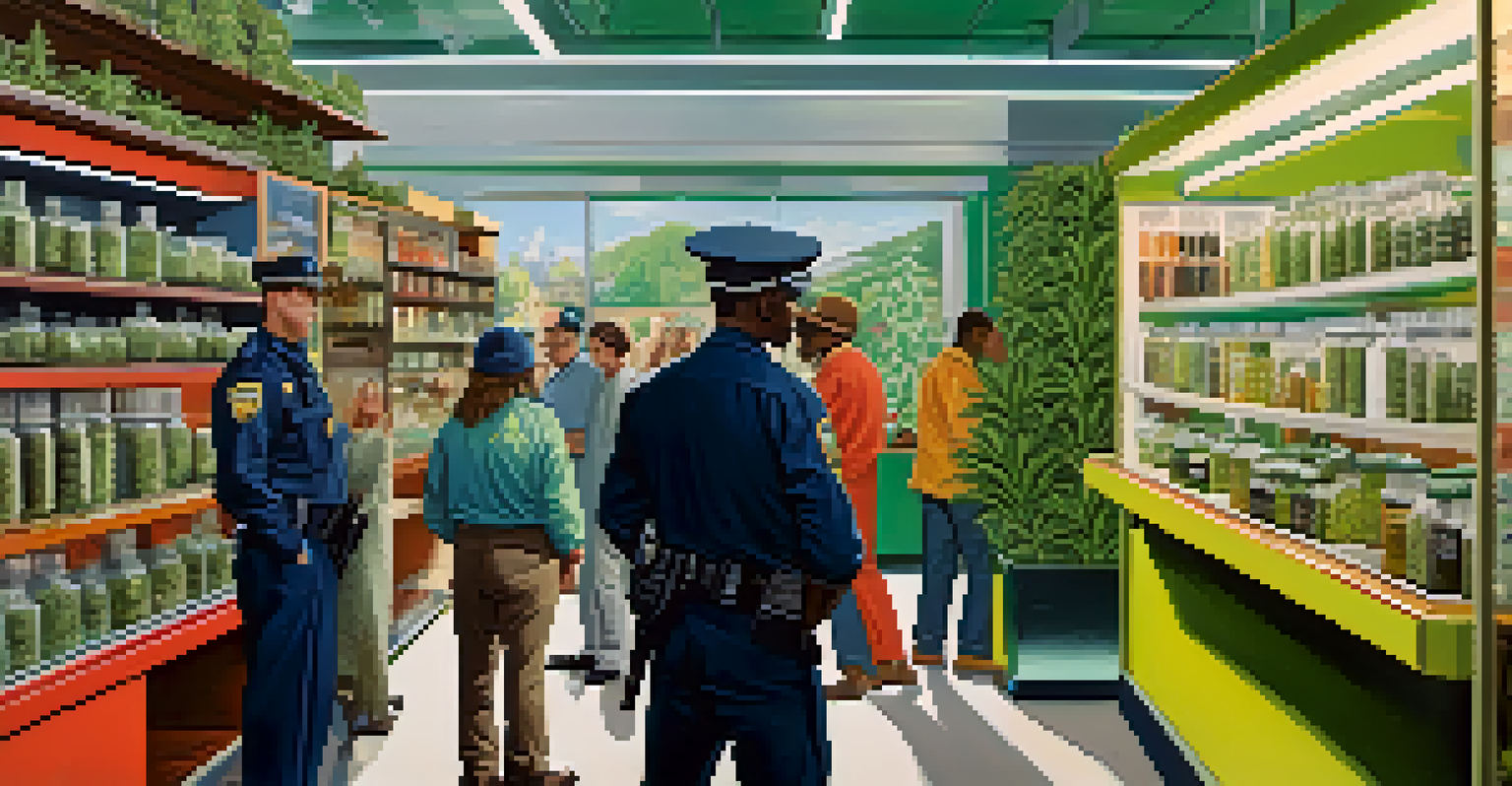Reefer Madness: The Propaganda Behind Marijuana Laws

The Origins of Reefer Madness and Its Cultural Impact
The term 'Reefer Madness' originates from a 1936 film that portrayed marijuana users as violent and insane. This sensationalized narrative was part of a broader campaign to demonize cannabis during a time of increasing regulation. The film’s exaggerated depictions played a crucial role in shaping public perception, making marijuana seem like a dire threat to society.
The greatest danger of marijuana is not its use, but the stigma associated with it.
As the film gained notoriety, it became a symbol of the fear-mongering tactics used by various organizations to push for stringent marijuana laws. It tapped into societal anxieties about drug use, particularly among youth, and framed cannabis as a gateway to moral decay. This cultural narrative laid the groundwork for the stigma that still surrounds marijuana today.
Reefer Madness not only influenced public opinion but also served as a powerful tool for policymakers. The film contributed to the passage of restrictive laws and the eventual criminalization of marijuana in the United States. The lingering effects of such propaganda can still be felt in ongoing debates about cannabis legalization.
The Role of Government in Marijuana Prohibition
In the early 20th century, the U.S. government began to take a more active role in regulating drugs, with marijuana becoming a key focus. The Marihuana Tax Act of 1937 effectively made cannabis illegal, basing its legitimacy on the exaggerated fears propagated by films like Reefer Madness. This act marked the beginning of a long history of marijuana prohibition that was largely fueled by misinformation.

Throughout the decades, the government continued to reinforce these negative stereotypes through various campaigns, often ignoring scientific research that contradicted their stance. This created a cycle where public perception was shaped by fear rather than facts, leading to harsh penalties for marijuana-related offenses. The consequences have been profound, contributing to mass incarceration and racial disparities in drug enforcement.
Reefer Madness Shaped Public Perception
The sensationalized narrative from the 1936 film 'Reefer Madness' played a significant role in creating lasting stigma and fear around marijuana use.
Despite the growing body of evidence supporting the medicinal benefits of marijuana, the government’s historical narrative has been hard to shake. The legacy of Reefer Madness still influences policy decisions today, demonstrating the lasting power of propaganda in shaping laws and public opinion about marijuana.
Media's Role in Shaping Marijuana Perception
The media has played a pivotal role in disseminating the messages depicted in Reefer Madness. Sensationalist headlines and stories often exaggerate the dangers of marijuana, reinforcing negative stereotypes and public fears. This portrayal has created a culture of misunderstanding surrounding cannabis use, making it difficult for rational discussions to take place.
Legalizing marijuana is not just about legalizing a drug; it’s about changing the way we think about addiction and health.
Even in contemporary media, the legacy of Reefer Madness can be seen in how marijuana-related stories are framed. Reports often focus on crime and addiction, neglecting the growing evidence of its benefits for mental health and pain relief. This skewed representation perpetuates the stigma and affects how society views those who consume cannabis.
As media continues to evolve, there is a growing need for balanced reporting on marijuana. By showcasing positive stories and scientific advancements, the media can help dismantle the outdated narratives left by Reefer Madness and foster a more informed public discourse on cannabis.
The Science Behind Marijuana: Debunking Myths
As research into marijuana has expanded, many of the myths perpetuated by Reefer Madness have been debunked. Studies have shown that cannabis can provide relief for various medical conditions, challenging the notion that it leads to violence or insanity. This scientific evidence is crucial for shifting public perception away from fear and toward understanding.
Moreover, the idea that marijuana serves as a gateway drug has been heavily scrutinized. Many experts argue that social factors, rather than the drug itself, often lead individuals to experiment with harder substances. This perspective is vital in reframing the conversation around cannabis use and its potential benefits.
Government Fueled Marijuana Myths
Historical government policies and campaigns perpetuated misinformation about marijuana, leading to severe consequences like mass incarceration.
By focusing on the science, advocates can help promote a more balanced view of marijuana. Emphasizing the therapeutic properties and potential for responsible use can contribute to a more informed public discussion and support for legalization efforts.
The Shift Towards Legalization: A New Era
In recent years, there has been a significant shift in public opinion regarding marijuana legalization. As more states move to legalize cannabis for medical and recreational use, the narrative surrounding marijuana is evolving. This change reflects a growing recognition of the harms caused by the war on drugs and the need for reform.
The success of legalization efforts can be attributed to the tireless work of advocates who have challenged the outdated beliefs stemming from Reefer Madness. By sharing personal stories and highlighting the benefits of cannabis, they have helped to humanize the issue and build broader support. This grassroots movement has played a pivotal role in changing laws across the country.
As we continue to see a shift toward legalization, it’s essential to remember the lessons from the past. The fight against the misinformation and stigma surrounding cannabis is far from over, but the progress made serves as a hopeful sign for the future of marijuana policy.
The Economic Impact of Marijuana Legalization
Legalizing marijuana has profound economic implications, from job creation to tax revenue. States that have embraced legalization are witnessing significant financial benefits, using funds to support education, healthcare, and infrastructure. The economic argument for legalization is becoming increasingly compelling as more data becomes available.
Furthermore, the cannabis industry has created thousands of jobs, from cultivation to retail, providing opportunities in communities that have been disproportionately affected by marijuana prohibition. This economic revival is crucial for changing perceptions and showcasing the potential of a regulated cannabis market.
Legalization Shifts Economic Perspectives
The legalization of marijuana is generating substantial economic benefits, including job creation and increased tax revenue, challenging outdated views.
The positive economic impact also highlights the need for a new narrative around marijuana. By emphasizing the financial benefits alongside the health advantages, advocates can further strengthen the case for legalization and challenge the remnants of Reefer Madness.
The Future of Marijuana Laws: What Lies Ahead
As we look to the future, the trajectory of marijuana laws remains uncertain but promising. With a growing number of states legalizing cannabis, the conversation is shifting toward regulation and safety. This progressive stance reflects a broader societal acceptance that contrasts sharply with the fear-based messaging of the past.
However, challenges remain, particularly at the federal level where marijuana is still classified as a Schedule I substance. This classification creates hurdles for research, banking, and interstate commerce, underscoring the need for comprehensive reform. Advocates continue to push for changes that acknowledge the evolution of public opinion and scientific understanding.

Ultimately, the future of marijuana laws will depend on ongoing advocacy, education, and an open dialogue about the realities of cannabis use. By addressing the remnants of Reefer Madness head-on, society can pave the way for a more informed and balanced approach to marijuana policy.